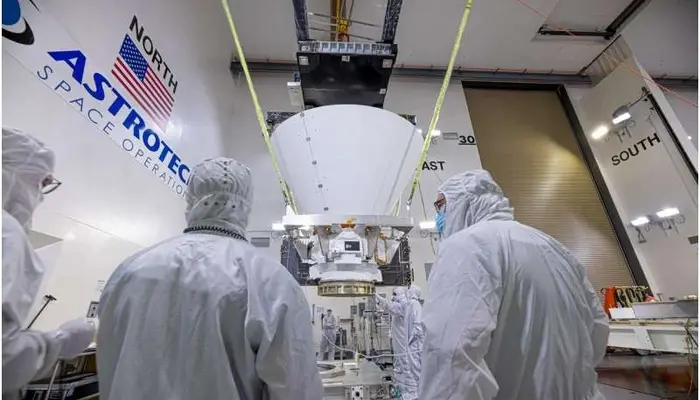SPHEREx Space Telescope to Search for Life’s Ingredients

NASA’s upcoming SPHEREx mission will scan the galaxy for essential compounds like water ice, carbon dioxide, and carbon monoxide—key ingredients for life. Set to launch on February 27 aboard a SpaceX Falcon 9 from Vandenberg Space Force Base, this groundbreaking mission aims to map the sky in infrared light to uncover the origins of water and other compounds crucial for life.
Tracking Life’s Building Blocks
SPHEREx will search molecular clouds—large regions of gas and dust where stars and planets form. Scientists believe most water in the universe forms as ice bound to dust grains in these clouds. This ice could later migrate to planets and moons, potentially forming oceans like those on Earth. By surveying these clouds, SPHEREx will help scientists understand the conditions under which life-sustaining compounds emerge.
Unique Observation Technique
Unlike previous telescopes, SPHEREx won’t capture just 2D images. Instead, it will collect 3D data along its line of sight, revealing the abundance and distribution of ice in molecular clouds. This capability will allow the telescope to track how the environment affects the formation of ice and other compounds. The mission will gather over nine million observations, creating the largest-ever map of frozen compounds in the galaxy.
Read: Apple Delays iPhone SE Launch For Upcoming Products
Learning from Past Missions
The SPHEREx mission builds on discoveries from earlier missions like NASA’s 1998 Submillimeter Wave Astronomy Satellite (SWAS), which detected far less water vapor in molecular clouds than expected. Researchers hypothesized that most water existed as ice deep inside the clouds.
These dust grains, shielded by the clouds from cosmic radiation, protect the ice from breaking apart. However SPHEREx will use absorption spectroscopy to identify frozen compounds by observing how starlight passing through a molecular cloud gets blocked by specific molecules.
Answering Key Questions
SPHEREx will explore how deep ice forms in molecular clouds and how its abundance changes as clouds grow denser or new stars form. These insights will help researchers piece together the complex process of star and planet formation.
Teaming Up with Webb
SPHEREx’s wide-survey capabilities will complement telescopes like NASA’s James Webb, which observes smaller areas with higher detail. If SPHEREx identifies intriguing targets, Webb can follow up with more precise observations, forming a powerful partnership in the search for life’s building blocks.
Mission Overview
SPHEREx is managed by NASA’s Jet Propulsion Laboratory (JPL) for the Astrophysics Division within NASA’s Science Mission Directorate. Built by BAE Systems, the mission will rely on scientists from multiple institutions across the U.S., South Korea, and Taiwan. Data will be processed and archived at IPAC at Caltech, with all findings made publicly available at the NASA/IPAC Infrared Science Archive.
Follow us on Google News, Instagram, YouTube, Facebook,Whats App, and TikTok for latest updates












